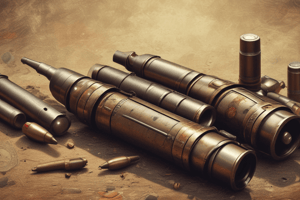Podcast
Questions and Answers
What is the key focus of classical ballistics?
What is the key focus of classical ballistics?
- Air resistance
- Gunpowder reactions
- Gunbarrel design
- Projectile motion (correct)
Which area of modern ballistics deals with the chemical reactions in gunpowder?
Which area of modern ballistics deals with the chemical reactions in gunpowder?
- Gunpowder reactions (correct)
- Gunbarrel design
- Air resistance
- Projectile motion
How does air resistance affect a projectile's trajectory?
How does air resistance affect a projectile's trajectory?
- It has no effect on the projectile's speed
- It increases the projectile's speed
- It decreases the projectile's speed (correct)
- It changes the projectile's shape
When does special relativity play a role in ballistics?
When does special relativity play a role in ballistics?
Which type of ballistics focuses on the flight of a projectile from launch to target?
Which type of ballistics focuses on the flight of a projectile from launch to target?
What is the purpose of studying gunbarrel design in modern ballistics?
What is the purpose of studying gunbarrel design in modern ballistics?
What is the quantum Hall effect?
What is the quantum Hall effect?
Which field benefits from understanding ballistics to design more effective systems?
Which field benefits from understanding ballistics to design more effective systems?
How are the principles of ballistics useful in forensic analysis?
How are the principles of ballistics useful in forensic analysis?
What is one significant application of ballistics in aircraft and aerospace?
What is one significant application of ballistics in aircraft and aerospace?
How does ballistics as a field of study contribute to understanding projectiles' behavior?
How does ballistics as a field of study contribute to understanding projectiles' behavior?
What new areas have ballistics started to encompass apart from weaponry and aerospace?
What new areas have ballistics started to encompass apart from weaponry and aerospace?
Flashcards are hidden until you start studying
Study Notes
Exploring the World of Ballistics: A Physics Primer
From military tactics to airsoft skirmishes, the physics behind projectile motion has captivated humans for thousands of years. Ballistics, the study of projectiles in motion, merges classical and modern physics to help us understand the behavior of bullets and other projectiles.
Classical Ballistics
The classical approach to ballistics, known as external ballistics, deals with the flight of a projectile from the moment of its launch until it hits its target. Key concepts include:
- Projectile Motion: Analyzing the projectile's path using Newton's Laws of Motion to determine speed, distance, and trajectory.
- Air Resistance: Quantifying how air drag slows the projectile and affects its trajectory.
Modern Ballistics
Modern ballistics, or internal ballistics, focuses on the behavior of a projectile and its interactions within the gun or launcher. Critical areas include:
- Gunpowder Reactions: Studying the chemical reactions that occur in gunpowder to produce the propulsive gases, which propel the projectile.
- Gunbarrel Design: Ensuring the gunbarrel's shape and material properties enhance the projectile's velocity and accuracy.
Relativity and Ballistics
Special relativity plays a role in ballistics when dealing with high-speed projectiles, where the projectile's mass can change as it approaches the speed of light.
Quantum Ballistics
In the quantum realm, ballistics can be seen in the study of electrons and other subatomic particles that behave like waves and particles. Quantum ballistics explores phenomena such as the quantum Hall effect, where electrons move through a material without resistance due to the presence of a strong magnetic field.
Applications of Ballistics
Ballistics has numerous applications, including:
- Military Weapons: Understanding ballistics helps develop more effective weapon systems and ammunition.
- Forensic Analysis: Ballistics can be used to analyze the trajectory and type of firearm used in a crime scene.
- Aircraft and Aerospace: The principles of ballistics are essential in designing aircraft and spacecraft.
Ballistics continues to evolve and expand to encompass new areas, such as the physics of electromagnetic waves and propulsion systems for hypersonic and interstellar travel. As a field of study, ballistics blends classical and modern physics to provide a comprehensive understanding of the behavior of projectiles, offering insights into weaponry, forensics, and aerospace engineering.
Studying That Suits You
Use AI to generate personalized quizzes and flashcards to suit your learning preferences.




